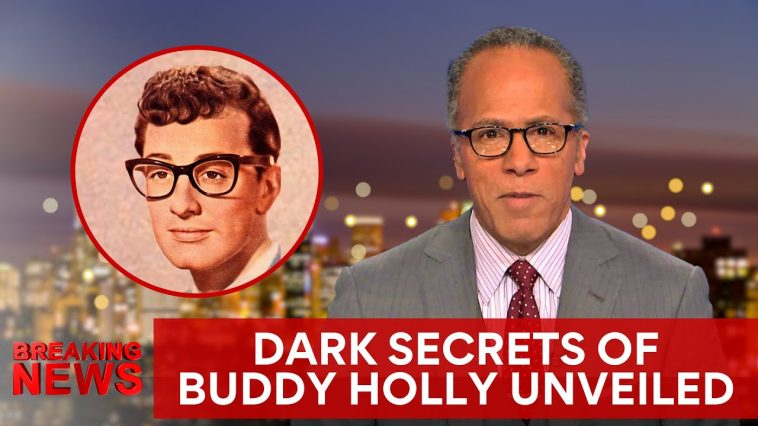We start with Holly’s humble beginnings and trace his meteoric rise to fame, shedding light on the grit and ambition that fueled his journey. Get ready to hear about Holly’s unique tastes in musical instruments, like the celesta, and how they influenced his distinct sound.
We’ll also delve into his personal life, where his love for music was equally matched by a turbulent love life. Learn about the coin toss that would become an eerie twist of fate, deciding who would board the ill-fated plane that led to the tragic end of three music legends.
Moreover, we’ll share details about the iconic glasses that almost became the stuff of urban legends. These glasses were not just fashion statements; they were a part of Buddy’s identity and contributed to the mystery surrounding his life after they went missing.
This video is a deep dive into the man who left an indelible mark on music history. It’s not just a retelling of widely known facts but an exploration of lesser-known and curious aspects that made Buddy Holly the complex artist he was. So sit back, relax, and join us as we journey through the life and times of Buddy Holly, covering ground from fascinating facts to hidden gems.
Welcome back, fellow music fans! Today we’re talking about Buddy Holly. A name that is synonymous with songs like “That’ll Be the Day,” “Peggy Sue,” and “Everyday.” These hits totally defined an era and are often what come to mind when you think of Holly.
Known for his trademark glasses and squeaky-clean image, Buddy Holly was considered the all-American poster boy of rock and roll. As you’re probably aware, his life was tragically cut short in a plane crash on February 3, 1959. It’s a day so impactful as “The Day the Music Died.”
Now, what if we told you there’s more to the Buddy Holly story? After his death, surprising details surfaced that add new layers to his legacy. In the next few minutes, we’re going to delve into these little-known facts. It might just change how you see this musical icon. So stick around, you won’t want to miss this!
Facts Verse Presents: The Dark Secrets of Buddy Holly Came Out After His Death
Humble Beginnings in Lubbock, Texas
Buddy Holly was born Charles Hardin Holley on September 7, 1936, in Lubbock, Texas. Born into a musical family, Buddy got an early start in understanding the power of a good tune. His parents, Lawrence and Ella Holley, had no clue that their fourth child would one day change the face of American music. The family wasn’t wealthy by any means; Buddy’s father worked as a tailor and his mother was a stay-at-home mom. The family loved to get together for jam sessions. Buddy’s two older brothers taught him the basics of the guitar.
Discovering His Passion for Music
By the time Buddy entered high school, he was smitten with music. Rock ‘n’ roll was just beginning to make its presence felt, and young Buddy couldn’t get enough of it. He was particularly fond of Elvis Presley and was mesmerized by the King’s groundbreaking musical style. Buddy decided early on that music wasn’t just a hobby; it was his life. He teamed up with childhood friend Bob Montgomery. The duo began performing at local events, quickly gaining a reputation as “Buddy and Bob.”
The Early Struggles and Small Triumphs
No path to fame is straightforward, and Buddy had his fair share of roadblocks. After a brief stint with a bluegrass outfit, Buddy began to experiment with his own sound. His early recordings didn’t make much noise, and Buddy found himself yearning for a break. That break came when a talent scout from Decca Records offered him a contract. The journey was far from smooth. After a series of recording sessions that led to unremarkable results, Decca chose not to renew his contract. For a lesser spirit, this might have been the end of the road, but not for Buddy.
Disappointed but not defeated, Buddy returned to Lubbock, where he formed a new band—The Crickets. It was with this group that Buddy finally struck gold. The Crickets’ unique blend of rock ‘n’ roll with a country twang resonated with the public. Their first major hit, “That’ll Be the Day,” catapulted Buddy and his band to national fame. The song was inspired by a phrase from the John Wayne movie “The Searchers,” and it didn’t take long for it to top the charts.
The Highs of Stardom and National Tours
Once “That’ll Be the Day” took off, there was no looking back. More hits followed, including “Peggy Sue” and “Oh Boy!” The band appeared on major national TV shows like “The Ed Sullivan Show” and “American Bandstand,” cementing their place in the rock ‘n’ roll spotlight. The Crickets’ sound, defined by Buddy’s distinctive vocal style and his unique approach to the guitar, had fans lining up in droves. Young musicians, inspired by Buddy’s innovative songwriting and performance techniques, found in him a new kind of rock ‘n’ roll hero.
Buddy Holly and The Crickets went on to release more than just chart-toppers; they created timeless classics. Songs like “Rave On” and “Maybe Baby” became anthems for the emerging youth culture. Their music combined elements of rock, rhythm and blues, and country in a way that had never been heard before. However, what really set Buddy apart was his songwriting skill. Unlike many of his contemporaries, Buddy wrote most of his songs, creating a legacy of original hits that would endure for decades.
A Love Story Cut Short
Love knocked on Buddy’s door in the form of Maria Elena Santiago. The pair met at a music publishing company where Maria Elena worked, and it was love at first sight. They married just two months after meeting. However, tragedy struck soon after their wedding when Maria Elena miscarried, due in part to the stress and shock following Buddy’s untimely death.
On February 3, 1959, Buddy Holly’s life came to an abrupt and tragic end, forever changing the landscape of rock ‘n’ roll. But what most people don’t know are the minor details and decisions that led up to that grim moment, making it all the more haunting.
Buddy Holly, Ritchie Valens, and J.P. “The Big Bopper” Richardson were part of the “Winter Dance Party” tour that was zigzagging through the Midwest. The grueling road trip was taking a toll on everyone. The tour bus had no proper heating, and one of the tour members had already suffered from frostbite. Fed up with the uncomfortable bus rides, Buddy decided to charter a plane to get to the next stop, Moorhead, Minnesota, a decision that would prove to be fatal.
Even the choice of who would be on that plane came down to a twist of fate. Originally, Buddy’s band member Waylon Jennings had a seat, but he gave it up for J.P. Richardson, who was sick with the flu. Ritchie Valens, who had never flown on a small plane before, was both excited and anxious about the experience. Famously, he won his seat in a coin toss against Tommy Allsup, another band member.
Pilot Roger Peterson, who was just 21, was eager but not well-equipped for the weather conditions that night. The flight took off from Mason City, Iowa, and was expected to be a quick one. But soon after takeoff, the plane spiraled out of control and crashed into a cornfield, killing all onboard instantly. The wreckage wasn’t found until the next morning, covered in a blanket of snow.
It was an event so shocking that singer Don McLean later dubbed it “The Day the Music Died” in his iconic song “American Pie,” a term that has since been universally adopted to describe this tragedy. The aviation accident report cited a combination of poor weather conditions and pilot error as the cause, but the emotional impact resonated far beyond those clinical details.
So many “what ifs” hang in the air when recounting that night: What if Waylon Jennings hadn’t given up his seat? What if the coin had landed the other way for Ritchie Valens? What if they had waited just one more day? These questions remind us how fragile life can be and how quickly fate can change. In that one chilling moment, the world lost three brilliant musicians, but their music continues to live on, a bittersweet reminder of what was and what could have been.
Unraveling The Unknown
Buddy Holly wasn’t just the guy with the catchy tunes and the geek-chic glasses. He was a complex individual with a fiercely independent spirit, and his story comes with its share of little-known facts, dark moments, and surprising twists.
Most fans associate Buddy Holly with his clean-cut image, but few know about his rebellious streak. In a time when artists often had little control over their music, Buddy took the reins. He wasn’t afraid to fight for his artistic freedom, even breaking ties with Decca Records over creative differences. He went on to become one of the first musicians to write, produce, and perform his own songs, paving the way for future artists to take control of their careers.
Another fascinating fact about Buddy is his penchant for unusual instruments. Though best known for his work on the guitar, he had a deep love for unconventional sounds. His recording of “Everyday” featured a celesta, a rare keyboard instrument that most people had never even heard of at the time. This wasn’t just a one-off experiment; it was a reflection of his constant urge to innovate and push musical boundaries.
Now, let’s delve into something really mysterious—the saga of Buddy Holly’s iconic glasses. After his untimely death, his glasses disappeared, seemingly lost to history. Remarkably, they resurfaced over 20 years later, hidden in a courthouse storage box. But finding them was just the start of another conflict. Maria, Buddy’s widow, and Buddy’s parents became embroiled in a legal tug-of-war over who should rightfully own these emblematic frames. The glasses finally found their way to Maria, who then donated them to the Buddy Holly Center in Lubbock, Texas, where they’re displayed as a tribute to his enduring legacy.
But it wasn’t just material objects that stirred controversy. Buddy’s family life was a complex tapestry of highs and lows. His relationship with his brothers is rocky, fueled by professional rivalry and personal disagreements that were never fully resolved. As a child, Buddy was a gifted student but also a bit of a troublemaker, often performing pranks that irritated his teachers but delighted his classmates.
Lastly, not many are aware of Buddy’s interest in mysticism. He is popular for having a collection of books about paranormal phenomena and had once consulted a fortune teller about his career, who ominously warned him to be cautious of his future. Though he laughed it off at the time, the grim prediction seems chillingly prophetic in hindsight.
Buddy’s Music Echos On
Even after his death, Buddy Holly’s influence on music has been vast. He inspired a range of musicians from The Beatles to Bruce Springsteen, and he was among the first group of inductees into the Rock and Roll Hall of Fame in 1986. Not only did he pioneer a whole new musical style, but he also changed how the music business worked, proving that artists could be more than just performers; they could be creators with control over their own destiny.
Wow, what a journey we’ve been on, diving into the life – and death – of the remarkable Buddy Holly. From his rise to fame to the lesser-known facets of his personality, we’ve covered a lot of ground in this video. But the story doesn’t end here; it lives on in his music, in the stories you share, and the memories we all hold.
So, we’re curious—what do you know about Buddy Holly that wasn’t mentioned here? Any deep dives or surprising facts you’d like to share? And of course, what’s your all-time favorite Buddy Holly song? Drop a comment below; we’d love to hear from you.
Take care, and as always, thanks for watching!



